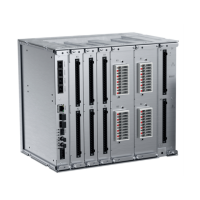Table 9. Power supply for the LHMI
Description Value
Nominal auxiliary voltage U
n
100, 110, 120, 220, 240 V AC, 50 and 60 Hz
24, 48, 60, 110, 125, 220, 250 V DC
Auxiliary voltage variation 38...110% of U
n
(38...264 V AC)
80...120% of U
n
(19.2...300 V DC)
Start-up threshold 19.2 V DC (24 V DC × 80%)
Burden of auxiliary voltage supply under quiescent (P
q
)/operating
condition
DC <6.0 W (nominal)/<14.0 W (max.)
AC <7.0 W (nominal)/<12.0 W (max.)
Ripple in the DC auxiliary voltage Max 15% of the DC value (at frequency of 100 Hz)
Fuse type T3.15A/250V
Table 10. Energizing inputs
Description
Value
Rated frequency 50/60 Hz
Current inputs Rated current, I
n
0.2/1 A
1/5 A
1)
Thermal withstand capability:
• Continuously 4 A 20 A
• For 1 s 100 A 500 A
Dynamic current withstand:
• Half-wave value 250 A 1250 A
Input impedance <100 mΩ <20 mΩ
Voltage inputs Rated voltage 57...240 V AC
Voltage withstand:
• Continuous 288 V AC
• For 10 s 360 V AC
Burden at rated voltage <0.05 VA
1) Residual current and/or phase current
Table 11. Energizing inputs (sensors)
Description
Value
Current sensor input Rated current voltage (in secondary
side)
75 mV...9000 mV
1)
Continuous voltage withstand 125 V
Input impedance at 50/60 Hz 4 MΩ
Voltage sensor input Rated primary voltage
6 kV...40.5 kV
2)
Continuous voltage withstand 50 V
Input impedance at 50/60 Hz 8 MΩ
1) Equals the current range of 40...4000 A with a 80 A, 3 mV/Hz Rogowski
2) This range is covered (up to 2*rated) with sensor division ratio of 10 000:1
1MRS759144 A

